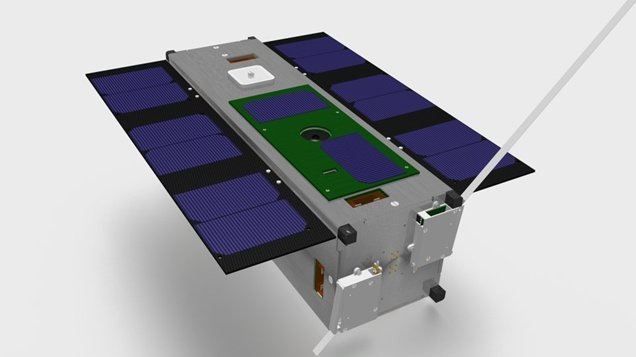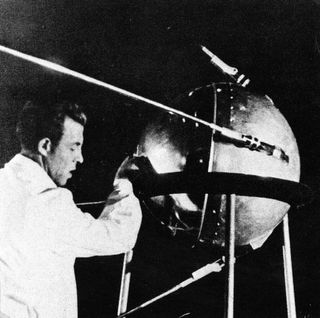World's 1st Smartphone Satellite Dials Earth from Space

A tiny satellite powered by a Google Nexus One smartphone has become the world's first "phonesat" to orbit Earth, its builders say.
The United Kingdom Space Agency's miniature STRaND-1 satellite launched into space on Monday (Feb. 25) is one of seven spacecraft riding into orbit aboard an Indian rocket. It will test several new space technologies, including its WARP DRiVE — a novel space propulsion technology that will test a water-alcohol based thruster system.
"We'd hate to pick up the bill on those roaming charges," UK Space Agency officials wrote via Twitter after the successful launch of the rocket, India's Polar Satellite Launch Vehicle, from the Satish Dhawan Space Centre in Sriharikota, India.
The STRaND-1 nanosatellite is a small, box-shaped Cubesat. It weighs just 9.4 pounds (4.3 kilograms) and is about nearly 12 inches (30 centimeters) long and 4 inches (10 cm) wide. It was built by the British Surrey Space Center and Surrey Satellite Technology Ltd., to serve as a spaceflight training and technology demonstration mission, officials said.
"This is a great example of the innovative approach that you can take with cubesats to develop and prove low cost commercial technologies for space while at the same time proving an exciting way of training and developing engineering skills," UK Space Agency's Chris Castelli, acting director of science, technology and exploration, said in a statement. "We wish the STRaND-1 team every success and look forward to seeing how the mission performs."
STRaND-1 combines its Google Nexus One Android-powered smartphone core with a Linux-based high-speed processor in order to control itself.
The nanosatellite is actually equipped with two new space propulsion systems. Its WARP DRiVE systems (short for Water Alcohol Resistojet Propulsion De-orbit Re-entry Velocity Experiment) will test a new way to intentionally destroy a satellite at the end of a mission by performing maneuvers that force the satellite to fall out of orbit. The second system is a set of eight electric "pulsed plasma thrusters" that will be tested during the mission, Surrey officials explained in a statement.
Get the Space.com Newsletter
Breaking space news, the latest updates on rocket launches, skywatching events and more!
There are apps for that
The STRaND-1 nanosatellite is also carrying several apps in its smartphone brain that serve crucial roles in the mission, Surrey officials added. They were selected during a Surrey-run Facebook contest in 2012 and include:
iTesla will recorded the strength of the magnetic field around STRaND-1 while in orbit.
STRaND Data App will display the smartphone's satellite telemetry on the phone itself so it can be photographed by an onboard camera.
360 App will use the built-in camera of STRaND-1's smartphone to take photos of Earth from space. The public can request images from the STRanD-1 satellite through the 360 app website.
Scream in Space App is designed to use the speakers in STRaND-1's smartphone to test the theory popularized by the tagline for the 1979 science fiction film "Alien." Surrey officials explained that "the app will play videos of the best screams while in orbit and screams will be recorded using the smartphone's own microphone."
In the United States, NASA is also developing its own version of the smartphone satellite. The U.S. space agency's aptly named PhoneSat project is expected to launch on a demonstration mission later this year.
Follow TechNewsDaily on Twitter @TechNewsDaily, or on Facebook.You can follow SPACE.com Managing Editor Tariq Malik on Twitter @tariqjmalik.

Join our Space Forums to keep talking space on the latest missions, night sky and more! And if you have a news tip, correction or comment, let us know at: community@space.com.

Tariq is the Editor-in-Chief of Space.com and joined the team in 2001, first as an intern and staff writer, and later as an editor. He covers human spaceflight, exploration and space science, as well as skywatching and entertainment. He became Space.com's Managing Editor in 2009 and Editor-in-Chief in 2019. Before joining Space.com, Tariq was a staff reporter for The Los Angeles Times covering education and city beats in La Habra, Fullerton and Huntington Beach. In October 2022, Tariq received the Harry Kolcum Award for excellence in space reporting from the National Space Club Florida Committee. He is also an Eagle Scout (yes, he has the Space Exploration merit badge) and went to Space Camp four times as a kid and a fifth time as an adult. He has journalism degrees from the University of Southern California and New York University. You can find Tariq at Space.com and as the co-host to the This Week In Space podcast with space historian Rod Pyle on the TWiT network. To see his latest project, you can follow Tariq on Twitter @tariqjmalik.
